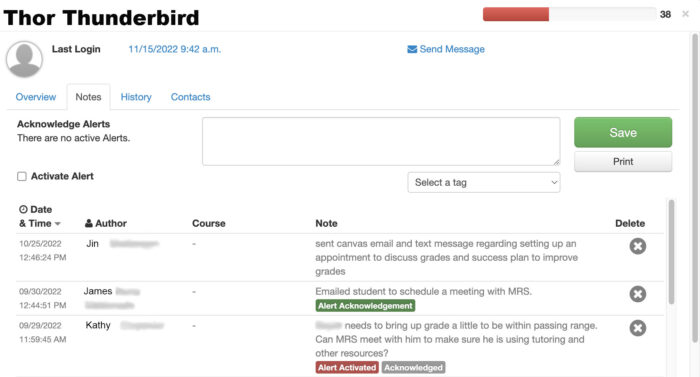Retention Strategies
Student success is at the core of our existence as a community college in preparing students to transfer or enter the workforce. Our completion rates have declined significantly in recent years, so it is important for us to focus efforts on increasing the numbers of students who successfully complete their degree or certificate or transfer to a four-year program.
For the purpose of MCC’s Wildly Important Goals, successful college completion is defined as the number of students in the first-time-in-college cohort who graduate or transfer within two years, along with the number of part-time students in the cohort who earn 30 or more college level credits within two years.
Mesa Community College’s WIG: Overall Successful Student Completion Outcomes
| Population | Fall 2018 Cohort Student Headcount | % Successful Outcome within two years | 2025 Goal Percentage | Point Gap |
| MCC Total | 2,300 | 11% | 16% | -5 |
What Is Dropout Detective? {How To Guides}
Student behavior can be a valuable indicator of student success and the best time to intervene is before they dropout or withdraw. Dropout Detective, integrated into our Canvas Learning Management System, is one aspect of our student success ecosystem at MCC. It serves as an early alert indicator that can assemble data of student behavior inside Canvas and displays a risk indicator dashboard.
The program basically analyzes past and current behavior to predict future performance. In addition, this program pulls together the different reasons the student is at risk of being unsuccessful and makes it easy to quickly go through and look at what might be happening with this student and determine an intervention strategy.

The data sits inside the course level for faculty view of their students for their class. Additionally data is displayed at an administrator level that displays student data across their courses so Coaches, Advisors, and Allies can determine students at risk and develop a proactive intervention strategy aimed at student success and retention. Dropout Detective is a crucial aspect of our Student Success ecosystem that can help provide the right support resources; to the right students; at the right time.
Faculty Use
Incorporate Dropout Detective as part of your normal Canvas routine, when you check and respond to email, visit the Dropout Detective Dashboard as well. The more frequently you check Dropout Detective the sooner you’ll be able to identify students who might be struggling and intervene before they fall too far behind.
Start with the students in Red, then Yellow, as these are the students who are most at risk of falling behind or off track completely. Click on the name of the student to see why they are at risk: low course grade, missing assignments, hasn’t logged in recently, and/or has missed assignments or hasn’t submitted an assignment recently. From this information, if you feel the student is at risk, the first step should be to email the student to see what’s going on and if they need some type of assistance such as: academic tutoring, life management assistance, technical help, etc.
Documentation Outreach
When you connect with a student it is helpful to the college retention team to document your efforts by saving “notes” in Dropout Detective. This will remind you what you have done in an attempt to assist your student and will inform any other retention specialists of your outreach. You can use “tags” to send a note directly to a specific retention specialist. People identified to respond to “tags” for specific support typically respond within 24 hours.
It is recommended that notes be descriptive of both the identified problem and the intervention ie: what you have done to help the student. As an example, if a student has missed several assignments, has a risk score of 80, and you have emailed them regarding getting caught up, you could write the following
Sample Note in Dropout Detective:
The student is missing homework assignments 3 and 4 and the discussion in Module 3. I emailed them, via Canvas Inbox, on 9/6 to remind them of the missing assignments and told them how they can get caught up in the class.
Visit: https://aspiredu.com/wp-content/uploads/2018/08/Dropout-Detective-Higher-Ed-Overview.pdf
If the student needs more than just encouragement, determine which area they need to contact (tutoring, counseling, financial aid, advising, etc.) and make an appropriate referral for additional resources. Record information in “notes” within Dropout Detective.
Use The Giant List of Resources. This list includes a lot of different types of student resources which may be helpful to serving in the role of a faculty ally. In the document, check out the section headings on the left for easy navigation.
Recommended Instructional Practices for Accurate Risk Indicators
Dropout Detective is only as effective as the data is accurate. This is completely dependent on the online learning experience. Through faculty who design online learning activities and students who engage (or don’t engage as the case may be.)
Faculty are crucial to the success of MCC being able to use Dropout Detective as the early alert to our overall Student Success ecosystem. Ways faculty can help ensure the institution is able to identify at-risk students and intervene in a timely manner is by doing a few crucial things inside Canvas:
- Create assignments in Canvas with current due dates
- Revise/Update/Keep Current all due dates (especially when copying from semester to semester)
- Remain current with your grade book
- Have students submit assignments in Canvas
- If you use MOER or another homework assignment system, import your grades into Canvas so retention staff can have accurate information about each student.


